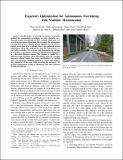Trajectory optimization for autonomous overtaking with visibility maximization
Author(s)
Andersen, Hans; Schwarting, Wilko; Naser, Felix; Eng, You Hong; Ang, Marcelo H.; Rus, Daniela; Alonso-Mora, Javier; ... Show more Show less
DownloadAccepted version (2.645Mb)
Open Access Policy
Open Access Policy
Creative Commons Attribution-Noncommercial-Share Alike
Terms of use
Metadata
Show full item recordAbstract
© 2017 IEEE. In this paper we present a trajectory generation method for autonomous overtaking of static obstacles in a dynamic urban environment. In these settings, blind spots can arise from perception limitations. For example, the autonomous car may have to move slightly into the opposite lane in order to cleanly see in front of a car ahead. Once it has gathered enough information about the road ahead, then the autonomous car can safely overtake. We generate safe trajectories by solving, in real-time, a non-linear constrained optimization, formulated as a Receding Horizon planner. The planner is guided by a high-level state machine, which determines when the overtake maneuver should begin. Our main contribution is a method that can maximize visibility, prioritizes safety and respects the boundaries of the road while executing the maneuver. We present experimental results in simulation with data collected during real driving.
Date issued
2017-10Department
Massachusetts Institute of Technology. Department of Electrical Engineering and Computer Science; Massachusetts Institute of Technology. Computer Science and Artificial Intelligence Laboratory; Singapore-MIT Alliance in Research and Technology (SMART)Publisher
IEEE
Citation
Andersen, Hans, Schwarting, Wilko, Naser, Felix, Eng, You Hong, Ang, Marcelo H. et al. 2017. "Trajectory optimization for autonomous overtaking with visibility maximization."
Version: Author's final manuscript